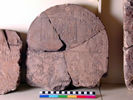
A festival is a periodically recurring religious celebration. The ancient Egyptian word for 'festival' was Hb. This word is found in personal names of men and women given at birth, such as the male personal name Horemheb 'Horus is in festival', indicating the reach of such events into the lives of individuals.
The title 'festival leader' is held at certain periods by middle-ranking officials, as on UC 8446, a statue of a man named Amenemipet from about 1400 BC; new research is needed for investigating their activities in detail.
Archaeological evidence for festivals remains little researched; the substantial deposits of votive offerings might result from sporadic visits by individuals to religious sites, rather than from festival offerings. For votive offerings to the goddess Hathor at sites from Sinai to Nubia, see Pinch 1993.
Written evidence for festivals
Siegfried Schott compiled a list of known festivals from the scattered references in ancient writings; most are only names, with relatively few known in any further detail from ritual manuscripts, monumental inscriptions and depictions. The terms Hbw nw pt 'festivals of heaven' and Hbw tp trw 'seasonal festivals' may reflect a division into those tied to movements of the moon and stars and those anchored in the agricultural cycle; however, this is difficult to apply as an absolute distinguishing criterion - the farming year started with the Nile flood in late summer, and this was heralded by the renewed rising of the bright star Sirius just before the sun at dawn.
From the Schott list, it seems that the principal festivals of ancient Egypt were annual events connected with the cult-place of a god or king. Festivals of the dead seem also to have been tied to main local temples, as at Thebes, where the Festival of the Valley combined banquets for the blessed dead with a procession of an image of Amun from Karnak to temples on the Theban West Bank.
A fragmentary late Middle Kingdom (about 2025-1700 BC) accounts papyrus, from Lahun, records the days served by dancers and singers at festivals (UC 32191).
Procession is the focus of the ancient Egyptian festival. The daily life of an ancient Egyptian temple revolved around food offerings, entrusted to small numbers of men; the temple was constructed primarily for that purpose, rather than as a place for congregations or prayer. Greater numbers participated in temple life only at the great festivals, in which the image of a deity was carried out of the temple, and in some cases transported by boat across larger distances.
In the Nile Valley, any substantial distance was most easily covered by boat; the boat of a deity was a prominent feature of cult. On stela UC 14495 a man named Shedsuhor is shown in worship before a boat with the figures of Osiris, Nut, Heqet and Horus.
 |
UC 14495 (click on the image for a larger picture and more information) |
From the New Kingdom to the Roman Period, the image of the deity was often carried even across shorter distances in a small boat-shrine, on two poles like a sedan chair. On stela UC 14404, acquired at Koptos but perhaps found at Thebes, two such boat-shrines are shown, one with ram-head prow and stern tips, the other with falcon heads. Although no inscriptions identify the boats, the ram and falcon elements indicate together that the upper boat is that of Amun, and the lower is that of Khons, the 'child-god' at Thebes.
Festivals as opportunities for oracles
The movement of a temple image offered closer access to divinity; from the New Kingdom the festival procession seems to have been the moment at which any person could present a yes-no question in front of the boat-shrine while it was being carried on poles - forward movement indicated the answer yes. Some Ramesside Period limestone flakes preserve the questions, written in hieratic (shorthand form of hieroglyphs), and the answers are preserved in longer documents of the same period and later. For a comprehensive account of the evidence for oracles see Cerny 1962. As in ancient Greece, ancient Egyptian 'oracles' offered a supplement to the administrative procedures of the law, for insoluble disputes, as a means of avoiding social disruption. Also as in Greece, the oracle might intervene at the highest level in decisions of state; the earliest recorded instances of divine intervention of this manner concern kings of Dynasty 18.
References
Copyright © 2003 University College London. All rights reserved.